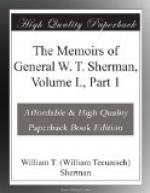along, and night and day he was harping on his scheme;
but he disgusted Colonel Mason with his flattery,
and, on reaching Monterey, he opened what he called
a law-office, but there were neither courts nor clients,
so necessity forced him to turn his thoughts to something
else, and quicksilver became his hobby. In the
spring of 1848 an appeal came to our office from San
Jose, which compelled the Governor to go up in person.
Lieutenant Loeser and I, with a couple of soldiers,
went along. At San Jose the Governor held some
kind of a court, in which Ricord and the alcalde had
a warm dispute about a certain mine which Ricord,
as a member of the Larkin Company, had opened within
the limits claimed by the New Almaden Company.
On our way up we had visited the ground, and were
therefore better prepared to understand the controversy.
We had found at New Almaden Mr. Walkinshaw, a fine
Scotch gentleman, the resident agent of Mr. Forbes.
He had built in the valley, near a small stream,
a few board-houses, and some four or five furnaces
for the distillation of the mercury. These were
very simple in their structure, being composed of
whalers’ kettles, set in masonry. These
kettles were filled with broken ore about the size
of McAdam-stone, mingled with lime. Another
kettle, reversed, formed the lid, and the seam was
luted with clay. On applying heat, the mercury
was volatilized and carried into a chimney-stack, where
it condensed and flowed back into a reservoir, and
then was led in pipes into another kettle outside.
After witnessing this process, we visited the mine
itself, which outcropped near the apex of the hill,
about a thousand feet above the furnaces. We
found wagons hauling the mineral down the hill and
returning empty, and in the mines quite a number of
Sonora miners were blasting and driving for the beautiful
ore (cinnabar). It was then, and is now, a most
valuable mine. The adit of the mine was at the
apex of the hill, which drooped off to the north.
We rode along this hill, and saw where many openings
had been begun, but these, proving of little or no
value, had been abandoned. Three miles beyond,
on the west face of the bill, we came to the opening
of the “Larkin Company.” There was
evidence of a good deal of work, but the mine itself
was filled up by what seemed a land-slide. The
question involved in the lawsuit before the alcalde
at San Jose was, first, whether the mine was or was
not on the land belonging to the New Almaden property;
and, next, whether the company had complied with all
the conditions of the mite laws of Mexico, which were
construed to be still in force in California.




